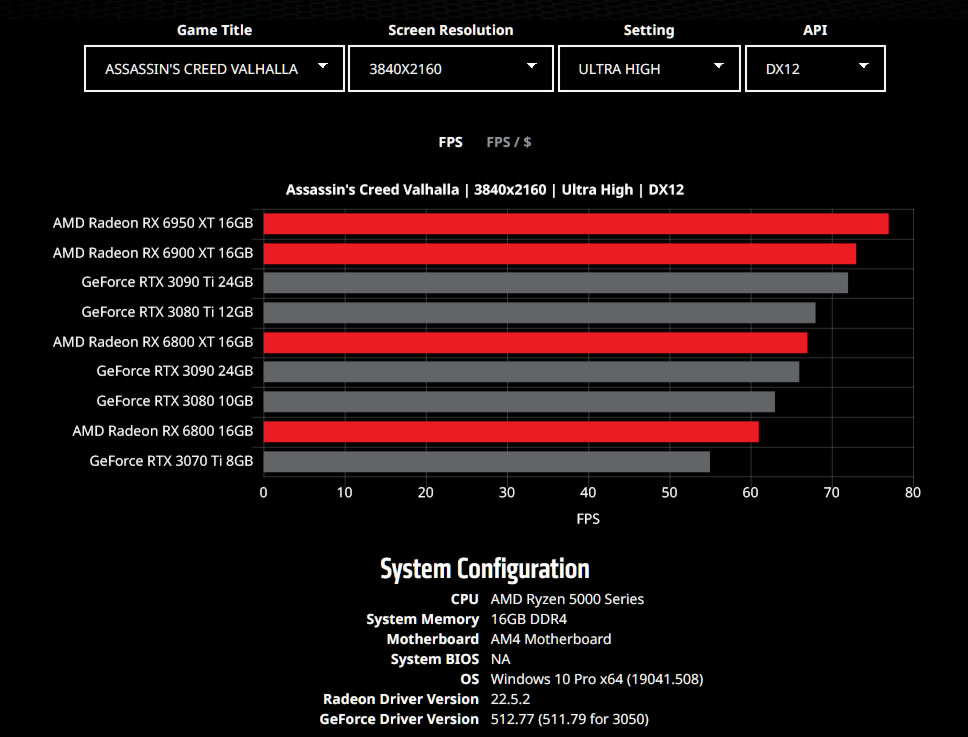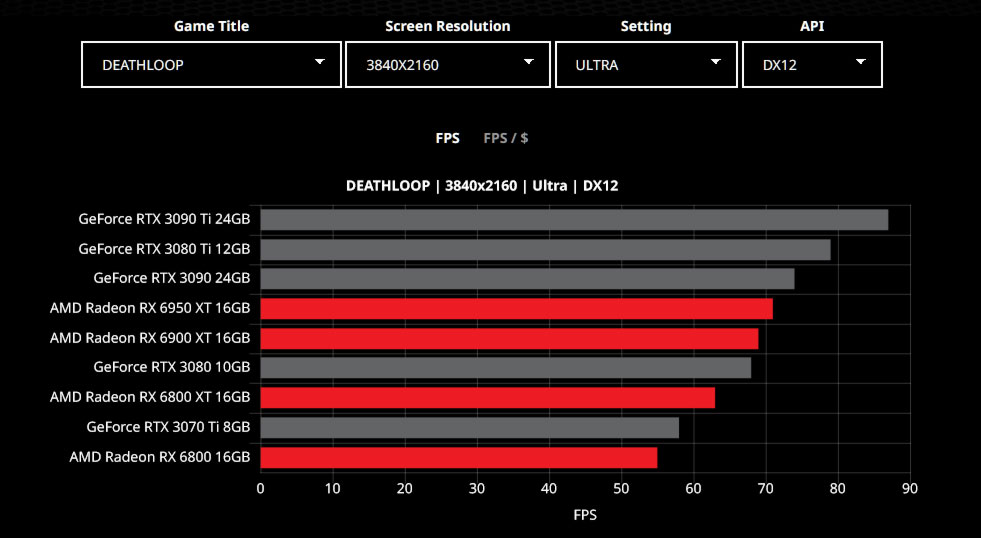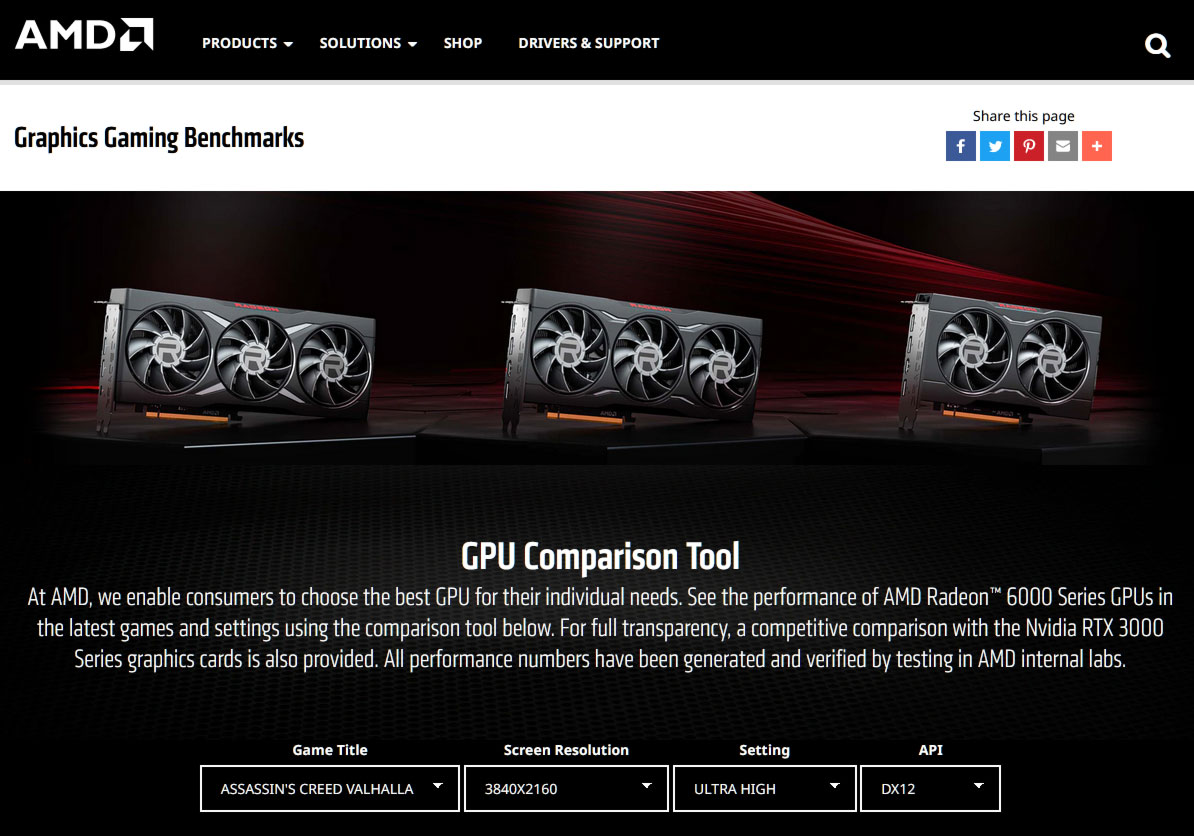AMD's New GPU Comparison Tool Makes No Hard Promises About Performance
AMD has launched its own online GPU Comparison Tool. This is a web page with drop down menus and a dynamic chart, which is touted as a tool to "enable consumers to choose the best GPU for their individual needs." It features nearly all the latest graphics cards from team red, and team green, as well as 11 popular PC games, the three most popular screen resolutions, and a handful of graphics quality and API toggles. There's also a bit of mysterious legalese to read through.
The best part of this tool is the extensive selection of AMD Radeon RX 6000 series GPUs, as well as all of Nvidia's GeForce RTX 30 series graphics cards. However, we note after prodding the menus and options, that AMD has decided to avoid any performance comparison charts featuring its Radeon RX 6500 XT or RX 6400 – even in eSports-style titles at 1080p. Whether AMD has any intentions to add them remains to be seen. Nvidia GPUs shown run the full gamut of the RTX 30 series from the RTX 3090 Ti at the top down the the RTX 3050.
With regard to these graphics cards and gaming comparisons, the tool is a little selective; if you opt for 1080p gaming in one of the titles you will see lower end GPUs compared, if you are pondering over 1440p or 4K gaming performance you will likely be presented with charts of mid-to-high end cards only.
AMD's games selection definitely raises some eyebrows. With 11 titles in the tool at the time of writing, it seems like a good number of them are very well optimized for Radeon performance. Straight off the bat; Assassin's Creed Valhalla, Deathloop and Resident Evil Village are promoted by AMD, while Tiny Tina's Wonderland and Fotza Horizon 5 are known to offer better performance on the platform. This raises questions of fairness. Some of the choices are kind of old and less popular, but there are some that actually show the GeForce cards rising to the top.


Another strong feeling we get from the new GPU Comparison Tool from AMD is that it is very much a work in progress. It isn't only the case that there aren't a great deal of games here, and the RDNA2 weaklings are missing, most of the time there aren't more than a single setting to choose from the quality menu or API menu.
There is some notable legalese in a small font below the tool, claiming that it is for "informational purposes only" and that "it may contain technical inaccuracies, omissions and typographical errors, and AMD is under no obligation to update or otherwise correct this information." So take that for what it's worth.
Will Nvidia and Intel feel like they have to make rival tools? That remains to be seen. However, we are still proud of what many PC techies think is the definitive GPU comparison chart – our frequently updated GPU Benchmarks and Hierarchy 2022: Graphics Cards Ranked page. As well as being stuffed with our own independent data, there is an overview chart where you can quickly see where your card, or intended card, sits in the performance stakes. Moreover, we have many detailed multi-page GPU reviews, and independent reviews are always the best way to go.
Get Tom's Hardware's best news and in-depth reviews, straight to your inbox.

Mark Tyson is a news editor at Tom's Hardware. He enjoys covering the full breadth of PC tech; from business and semiconductor design to products approaching the edge of reason.
-
-Fran- The intention is definitely good, I'll give them that. Now, how can this not be biased? Come on AMD, at least put somewhere how you sourced the data or tested it.Reply
I think the footnotes are really quaint, to say the least:
GPU Comparison Tool ConfigurationsAMD Ryzen 9 5900X for AMD Radeon RX 6700 and higher configuration. AMD Ryzen 5 5600X for other configurations.
AMD Ryzen 9 5900X for Geforce 3060Ti and higher configurations. AMD Ryzen 5 5600X for other configurations.
FPS/$ calculation is based on lowest Newegg website USD prices on June 20th, 2022.Testing by AMD Performance labs as of 12/14/2021, based on the average FPS of 6 PC games at 1920x1080 with the high image quality preset using an AMD Ryzen™ 7 5800X3D processor vs. Core i9-12900K. For Ryzen 5000 G-Series processors testing as of 5/5/2021, based on the average FPS of 11 PC games at 1920x1080 with the low image quality preset using an AMD Ryzen™ 7 5700G vs Core i7-11700, both configured with integrated graphics. Results may vary. R5K-002.
Testing by AMD performance labs as of 09/01/2020. Multithreaded performance evaluated with Cinebench R20 nT with a Ryzen 9 5950X vs. a Core i9-10900K in a similar configuration. Results may vary. R5K-005.
Testing by AMD Performance Labs as of May 5, 2021 using a Ryzen 7 5700G, Ryzen 5 5600G and Ryzen 3 5300G vs Intel Core i7-11700, Core i5-11600 and Core i3-10300 in 3DMark Time Spy using integrated graphics. Results may vary with configuration. R5K-070
Work in progress for sure. Let's see how it evolves.
Regards. -
hannibal Well this is just normal company advertising brochure...Reply
That is why we need also independent tests sites!
And nothing wrong in sites like that, but they still are some caveats. But this could be really useful to compare AMD product to other AMD product and Nvidia gpus to other NVidia gpus.
